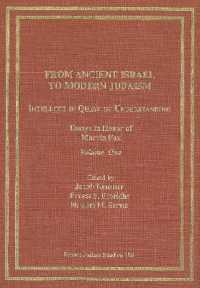- ホーム
- > 洋書
- > 英文書
- > Religion / Ethics
Full Description
For the Muslim faithful, the familiar sound of the Qurʾanic recitation is the predominant and most immediate means of contact with the Word of God. Heard day and night, on the street, in taxis, in shops, in mosques, and in homes, the sound of recitation is far more than the pervasive background music of daily life in the Arab world. It is the core of religious devotion, the sanctioning spirit of much cultural and social life, and a valued art form in its own right. Participation in recitation, as reciter or listener, is itself an act of worship, for the sound is basic to a Muslim's sense of religion and invokes a set of meanings transcending the particular occasion.
For the most part, Westerners have approached the Qurʾan much as scriptural scholars have studied the Bible, as a collection of written texts. The Art of Reciting the Qurʾan aims at redirecting that focus toward a deeper understanding of the Qurʾan as a fundamentally oral phenomenon. By examining Muslim attitudes toward the Qurʾan, the institutions that regulate its recitation, and performer-audience expectations and interaction, Kristina Nelson, a trained Arabist and musicologist, casts new light on the significance of Qurʾanic recitation within the world of Islam. Her landmark work is of importance to all scholars and students of the modern Middle East, as well as ethnomusicologists, anthropologists, linguists, folklorists, and religious scholars.
Contents
Transcription Tables
Acknowledgments
Introduction
1. The Text: The Qurʾan
History of the Revelation and Compilation of the Written Text
Nature of the Text
External Form of the Text
Content, Language, and Style
2. Tajwīd
Introduction
Material of Tajwīd
Sound of Tajwīd
3. The Samāʿ Polemic
4. The Ideal Recitation of the Qurʾan
Issues
Terminology
Ḥuzn
5. The Sound of Qurʾanic Recitation
Introduction
Murattal
Mujawwad
6. Maintaining the Ideal Recitation of the Qurʾan
7. Overlap and Separation: The Dynamics of Perception and Response
Introduction
The Overlap of Music and Recitation
The Separation of Music and Recitation
Conclusion
Appendix A. Consultants
Appendix B. The Seven Aḥruf and the Qirāʾāt
Notes
Selected Bibliography
Index






